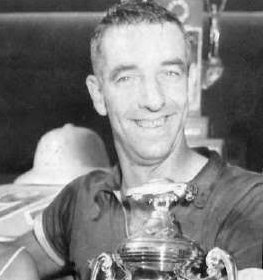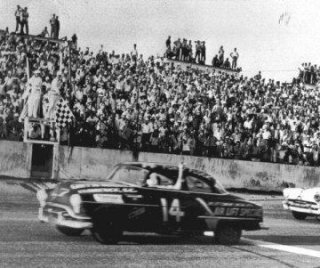Herb Thomas

Herb Thomas was one of the most respected and successfull racers of his day.
Herb Thomas was another driver who had been with the Grand National circuit since the beginning. A North Carolina farmer, Thomas was known on the track as a charger. He could race and win on any type of track, in any make of car. The previous year, Thomas won seven events in 36 starts, and was a terror in his “Fabulous Hudson Hornet.” Thomas’ #92 was always a contender.
After the Detroit win, Tim Flock was hoping to add another win to his tally a few days later at Stamford Park in Niagara Falls,but fate intervened.
Everyone knows racing is a dangerous sport, but sometimes things happened to drivers before the cars hit the track. That was the case at Niagra Falls. While parked before the event, a thunderstorm brought down a huge oak limb onto the top of Flock and Thomas’ Hudsons before the race at Stamford Park. Mechanics were able to fix the damage, and both cars raced that day.
Tim was eliminated in lap 78 when he struck the Oldsmobile of Eddie Lenz as Lenz’s car rolled end over end. Nobody was injured, fortunately. Buddy Shuman won the race, and was one of only three cars running at the end, along with Thomas and Ray Duhigg.
Tim padded his points lead while picking up wins in the next to races at Shangri-La in Owego, NY, and at Monore, Michigan. Lee Petty would end his drought with a win at Morristown, New Jersey, while Tim ran second. Tim would better Petty in the next race at Playland Park in Indiana by beating the North Carolina racer for the win. The Georgia speedster would add another victory to his tally in the next event at Rochester, New York, padding his points lead to 258 over Thomas.
In Weaverville, NC, a Flock again visited victory lane, but not Tim or Fonty. Bob Flock, the oldest of the brothers, made his return to Grand National racing after a 1951 crash that left him with a broken neck and several broken ribs. He scored the win at Asheville-Weaverville Speedway by two laps over Tim in second.
At Darlington, the Flock name again was the story for the Southern 500. But again, it wasn’t Tim.

Fonty Flock waves to the crowd as he takes the checkered flag in the 1952 Southern 500.
Fan favorite Fonty Flock took his Oldsmobile Rocket 88 to victory lane after starting from the pole, winning by a lap over second place.
After the race, Fonty entered NASCAR legend by standing on the hood of the car on the front stretch, and leading the more than 32,000 race fans in attendance in the singing of “Dixie.” He was still wearing his racing uniform, which consisted of a keen pair of Bermuda shorts.
“Fonty was a jokester,” Tim would recall years later in Larry Fieldon’s book Tim Flock, Race Driver. “He would actually ride around the track in Darlington when he won in ‘52 waving at the crowd, playing the radio, he had a radio in the car. He won the race in ‘52 in Bermuda shorts, nobody had ever drove a car in Bermuda shorts.”
Thomas would finish third, retaking the points lead after a crash relegated Tim to 33rd. Thomas led the chase by 134 points.
Thomas appeared to be on his way to padding that points lead at Macon, Georgia, when he blew a tire on his Hudson with just six laps remaining. That gave the win to Lee Petty. Thomas would finish second while Tim Flock finished third.
Petty made it two in a row by grabbing the win at the famous mile at Langhorne, with Tim finishing third, regaining the points lead by 234 after a crash sidelined Thomas 61 laps in.

New York's Larry Mann lost his life in a crash in his Hudson at Langhorne in September.
But the race was marred by tragedy, as Larry Mann, out of Yonkers, New York, died from injures he suffered when his Hudson Hornet flipped end over end. Mann’s car was painted green, reinforcing the old racing taboo of the color being bad luck.
Five races now remained to decide the title. Lee Petty appeared to have bagged his third win in a row when he was flagged the winner at Dayton. But a protest gave the win to Hudson pilot Dick Rathmann after officials determined Petty had been credited with one lap too many.
Oddly enough, in 1959, Petty would take a win away from his son, Richard, at Atlanta’s Lakewood Speedway under the same circumstances.
